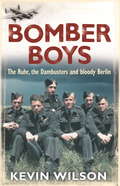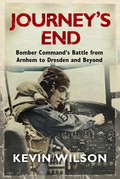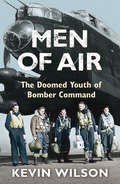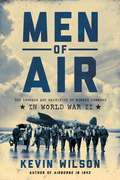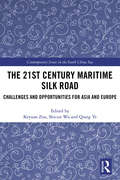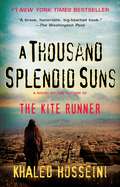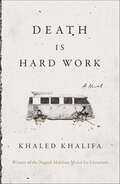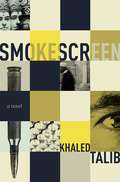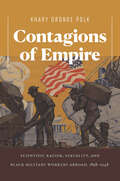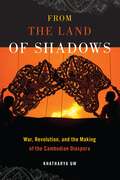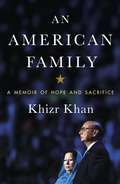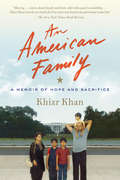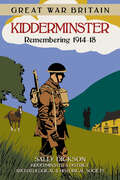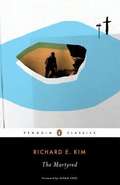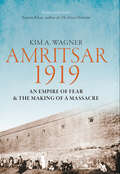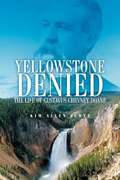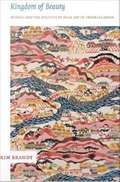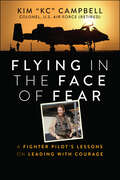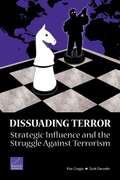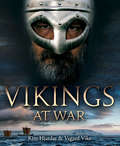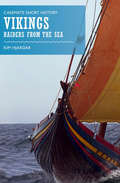- Table View
- List View
Bomber Boys: The RAF Offensive of 1943
by Kevin WilsonA gripping account of the everyday heroism of British bomber crews in 1943 - the year when Bomber Command believed it could win WWII by bombing alone.In 1943 the RAF began a bombing campaign against Germany, the like of which had never before been seen. Over the next twelve months, tens of thousands of aircrews flew across the North Sea to drop their bombs on German cities. They were opposed not only by the full force of the Luftwaffe, but by a nightmare of flak, treacherously icy conditions, and constant mechanical malfunction. Most of these crews never finished their tour of operations but were either shot down and killed, or taken prisoner by an increasingly hostile enemy.This is the story of the everyday heroism of British bomber crews in the days when it was widely believed that the Allies could win the Second World War by bombing alone. Kevin Wilson has interviewed hundreds of former airmen about what their lives were like in 1943: the stomach-churning tension of flying repeatedly over hostile territory, the terror at being shot down or captured, and the peculiar mixture of guilt and pride at unleashing such devastation on Germany.
Bomber Boys: The Raf Offensive Of 1943 (Wn Military Ser.)
by Kevin WilsonA gripping account of the everyday heroism of British bomber crews in 1943 - the year when Bomber Command believed it could win WWII by bombing alone.In 1943 the RAF began a bombing campaign against Germany, the like of which had never before been seen. Over the next twelve months, tens of thousands of aircrews flew across the North Sea to drop their bombs on German cities. They were opposed not only by the full force of the Luftwaffe, but by a nightmare of flak, treacherously icy conditions, and constant mechanical malfunction. Most of these crews never finished their tour of operations but were either shot down and killed, or taken prisoner by an increasingly hostile enemy.This is the story of the everyday heroism of British bomber crews in the days when it was widely believed that the Allies could win the Second World War by bombing alone. Kevin Wilson has interviewed hundreds of former airmen about what their lives were like in 1943: the stomach-churning tension of flying repeatedly over hostile territory, the terror at being shot down or captured, and the peculiar mixture of guilt and pride at unleashing such devastation on Germany.
Journey's End: Bomber Command's Battle from Arnhem to Dresden and Beyond
by Kevin WilsonThe final, climactic volume of Wilson's acclaimed bomber war trilogy. In February 1945, British and American bombers rained down thousands of tons of incendiaries on the city of Dresden, creating one of the greatest firestorms in history. Their bombs killed an estimated 25,000 people, and wiped one of the most beautiful cities in Europe from the map. The controversy that erupted shortly afterwards, and which continues to this day, has long overshadowed the other events of the bomber war, and blighted the memory of the young men who gave their lives to fight in the skies over Germany.This book neither condemns the bombing of Dresden, nor excuses it, but simply puts it in its proper context as a devastating set of raids in a much larger campaign. To the crews who flew over Germany night after night there were other much more pressing worries: the V2 rockets that threatened their loved ones at home, the brand new German jet fighters that could strike them at speeds of over 600mph, the deadly flak over the cities of the Ruhr Valley. The bomber war had entered its final unforgiving months, and no quarter was given on either side. Kevin Wilson has interviewed over a hundred people for this book, some of whom flew on the Dresden raids, and many more who experienced other aspects of bombing, both in the air and on the ground. JOURNEY'S END chronicles the brutal endgame of a conflict that caused devastation and tragedy on both sides.
Journey's End: Bomber Command's Battle from Arnhem to Dresden and Beyond
by Kevin Wilson'A brilliant insight into life in the air and on the ground' ObserverIn February 1945, British and American bombers rained down thousands of tons of incendiaries on the city of Dresden, killing an estimated 25,000 people and destroying one of the most beautiful cities in Europe. The controversy that erupted shortly afterwards, and which continues to this day, has long overshadowed the other events of the bomber war, and blighted the memory of the young men who gave their lives to fight in the skies over Germany.Journey's End neither condemns nor condones the bombing of Dresden, but puts it in its proper context as part of a much larger campaign. To the young men who flew over Germany night after night there were other much more pressing worries: the V2 rockets that threatened their loved ones at home; the brand new German jet fighters that could strike them at speeds of over 600mph. They lived life at a heightened tempo during these final unforgiving months of the bomber war when no quarter was given on either side.As the climactic volume in Kevin Wilson's acclaimed bomber war trilogy, Journey's End chronicles the brutal endgame of a conflict that caused such devastation and tragedy on both sides.
Men Of Air: The Doomed Youth Of Bomber Command
by Kevin WilsonThe story of the everyday heroism of British bomber crews in 1944 - the turning point year in Bomber Command's war against Germany.There were many ways for a combat crew to die during Bomber Command's war of 1944. Over German territory, bursts of heavy flak could tear the wings from their planes in a split second. Flaming bullets from German fighter planes could explode their fuel tanks, cut their oxygen supplies, destroy their engines. In the spring of that year, thousands of young men were shot, blown up, or thrown from their planes five miles above the earth; and even those who returned faced the subtler dangers of ice and fog as they tried to land their battered aircraft back home.The winter of 1944 was the most dangerous time to be a combat airman in RAF Bomber Command. The chances of surviving a tour were as low as one in five, and morale had finally hit rock bottom. In this comprehensive history of the air war that year, Kevin Wilson describes the most dangerous period of the Battle of Berlin, and the unparalleled losses over Magdeburg, Leipzig and Nuremberg. He tells how ordinary men coped with constant pressure of flying, the loss of their colleagues, and the threat of death or capture. And, by telling the story of the famous events of this period - the Great Escape, D-Day, the defeat of the V1 menace - he shows how, through sheer grit and determination, the 'Men of Air' finally turned the tide against the Germans.
Men Of Air: The Doomed Youth Of Bomber Command
by Kevin WilsonThe story of the everyday heroism of British bomber crews in 1944 - the turning point year in Bomber Command's war against Germany.There were many ways for a combat crew to die during Bomber Command's war of 1944. Over German territory, bursts of heavy flak could tear the wings from their planes in a split second. Flaming bullets from German fighter planes could explode their fuel tanks, cut their oxygen supplies, destroy their engines. In the spring of that year, thousands of young men were shot, blown up, or thrown from their planes five miles above the earth; and even those who returned faced the subtler dangers of ice and fog as they tried to land their battered aircraft back home.The winter of 1944 was the most dangerous time to be a combat airman in RAF Bomber Command. The chances of surviving a tour were as low as one in five, and morale had finally hit rock bottom. In this comprehensive history of the air war that year, Kevin Wilson describes the most dangerous period of the Battle of Berlin, and the unparalleled losses over Magdeburg, Leipzig and Nuremberg. He tells how ordinary men coped with constant pressure of flying, the loss of their colleagues, and the threat of death or capture. And, by telling the story of the famous events of this period - the Great Escape, D-Day, the defeat of the V1 menace - he shows how, through sheer grit and determination, the 'Men of Air' finally turned the tide against the Germans.
Men of Air: The Courage And Sacrifice Of Bomber Command In World War Ii
by Kevin WilsonThe story of the everyday heroism of bomber crews in 1944, a turning point in the war against Germany. Bomber combat crews faced a wide array of perils as they flew over German territory. Bursts of heavy flak could tear the wings from their planes in a split second. Flaming bullets from German fighter planes could explode their fuel tanks, cut their oxygen supplies, destroy their engines. Thousands of young men were shot, blown up, or thrown from their planes five miles above the earth; and even those who returned faced the subtler dangers of ice and fog as they tried to land their battered aircraft back home. The winter of 1944 was the most dangerous time to be a combat airman in RAF Bomber Command. The chances of surviving a tour were as low as one in five, and morale had finally hit rock bottom. In this comprehensive history of the air war that year, Kevin Wilson describes the most dangerous period of the Battle of Berlin, and the unparalleled losses over Magdeburg, Leipzig and Nuremberg. Men of Air reveals how these ordinary men coped with the extraordinary pressure of flying, the loss of their colleagues, and the threat of death or capture. Brilliantly placing these stories within the context of The Great Escape, D-Day, the defeat of the V1 menace, and more, Wilson shows how the sheer grit and determination of these "Men of Air" finally turned the tide against the Germans.
The 21st Century Maritime Silk Road: Challenges and Opportunities for Asia and Europe (Contemporary Issues in the South China Sea)
by Shicun Wu Keyuan Zou Qiang YeThis book explores the opportunities and challenges that both Europe and Asia face under the framework of the 21st Century Maritime Silk Road Initiative. The 21st Century Maritime Silk Road Initiative (MSR Initiative), put forward by the Chinese government together with the Silk Road Economic Belt, reflects China’s ambition and vision to shape the global economic and political order. The first step and priority under the MSR Initiative, according to documents issued by China, is to build three ‘Blue Economic Passages’ linking China with the rest of the world at sea, two of which will connect China with Europe. This initiative, however, still faces enormous challenges of geopolitical suspicion and security risks. This book seeks to assess these risks and their causes for the cooperation between the Eurasian countries under the framework of MSR and puts forward suggestions to deal with these risks in the interdisciplinary perspectives of international relations and international law. Featuring a global team of contributors, this book will be of much interest to students of Asian politics, maritime security, international law and international relations.
A Thousand Splendid Suns (Readers Circle Ser.)
by Khaled HosseiniPropelled by the same superb instinct for storytelling that made The Kite Runner a beloved classic, A Thousand Splendid Suns is at once an incredible chronicle of thirty years of Afghan history and a deeply moving story of family, friendship, faith, and the salvation to be found in love. After 103 weeks on the New York Times bestseller list and with four million copies of The Kite Runner shipped, Khaled Hosseini returns with a beautiful, riveting, and haunting novel that confirms his place as one of the most important literary writers today. Born a generation apart and with very different ideas about love and family, Mariam and Laila are two women brought jarringly together by war, by loss and by fate. As they endure the ever escalating dangers around them-in their home as well as in the streets of Kabul-they come to form a bond that makes them both sisters and mother-daughter to each other, and that will ultimately alter the course not just of their own lives but of the next generation. With heart-wrenching power and suspense, Hosseini shows how a woman's love for her family can move her to shocking and heroic acts of self-sacrifice, and that in the end it is love, or even the memory of love, that is often the key to survival.A stunning accomplishment, A Thousand Splendid Suns is a haunting, heartbreaking, compelling story of an unforgiving time, an unlikely friendship, and an indestructible love.
A Thousand Splendid Suns: ए थाउजंड स्प्लेन्डिड सन्स
by Khaled Hosseiniअफगणिस्तानातील ३० वर्षांच्या काळातल्या अस्थिर प्रसंगांची श्वास रोखून भरायला लावणारी मारियम आणि लैला यांची ही कथा. ही कथा वाचताना तालिबानच्या प्रदेशावरील सोव्हिएत आक्रमणापासून ते तालिबानच्या पुनर्स्थापनेपर्यंतच्या सत्तापालटाच्या कालखंडातील संघर्षमय प्रवास तुम्ही अनुभवाल. हिंसाचार, भय, आशा, श्रद्धा, यांवर जबरदस्त विश्वात असलेल्या देशातील मनोव्यापारांचा हा आलेख आहे. व्यक्तिगत आयुष्यातील धडपडीत झगडून टिकून यहण्यासाठी करायला लागणाऱ्या संधर्वाची दोन पिळबातील ही शोकांतिका आहे आणि तरीही पोबलाली फिरणाऱ्या गुंतागुंतीच्या प्रसंगातूनही आनंद शोधताना कथेमध्ये वाचकाला पूर्ण गुंतवून ठेवते.
Death Is Hard Work: A Novel
by Khaled KhalifaNational Book Award Finalist: “The poetic and horrific combine in this tale of love and death set in a Syria torn apart by civil war” (Guardian, UK).As elderly Abdel Latif dies peacefully in a hospital bed in Damascus, he relays his final wish to his youngest son Bolbol: to be buried in the family plot in their ancestral village of Anabiya. Though Bolbol is estranged from his siblings, he persuades his older brother Hussein and his sister Fatima to accompany him and the body to Anabiya, which is—after all—only a two-hour drive from Damascus. There’s only one problem: Their country is a war zone.With the landscape of their childhood now a labyrinth of competing armies whose actions are at once arbitrary and lethal, the siblings’ decision to set aside their differences and honor their father’s request quickly balloons from a minor commitment into an epic and life-threatening quest. Syria, however, is no longer a place for heroes, and the decisions the family must make along the way—as they find themselves captured and recaptured, interrogated, imprisoned, and bombed—will prove to have enormous consequences for all of them.One of Syria’s most acclaimed literary voices, Khaled Khalifa was the greatest chronicler of his country’s catastrophic civil war. In Death is Hard Work, he delivers a tale of three ordinary people facing down the stuff of nightmares armed with little more than simple determination.Winner of the Naguib Mahfouz Medal for LiteratureFinalist for the National Book Award for Translated Literature
Smokescreen
by Khaled TalibAt an ancient café in Cairo, two veteran spies plot a covert mission to resolve -- once and for all -- the Israeli - Palestinian conflict. The pledge: Israel will make a major concession as part of the peace treaty. In Singapore, Jethro Westrope, a magazine journalist, stumbles onto the scene of a murder: the beautiful Niki Kishwani directs him, in her last breath, to a digital recorder, evidence that puts Jethro's life in serious danger. And, much worse, he is framed for Niki's murder. Jethro sets out to find Niki's killer and is drawn into a web of deception and intrigue involving officials from the Singaporean, Israeli, and American governments, each with a complex, competing, and potentially deadly agenda. Against this pulse-pounding backdrop, Jethro races to find answers and save himself --yet nothing is as it seems. He finds himself at the center of a political plot so diabolical and sweeping in its world implications that he is stunned to discover tomorrow's news headlines today. He is being set up not only as a murderer but as an assassin, and something much larger than his own fate is in his hands.
Contagions of Empire: Scientific Racism, Sexuality, and Black Military Workers Abroad, 1898–1948
by Khary Oronde PolkFrom 1898 onward, the expansion of American militarism and empire abroad increasingly relied on black labor, even as policy remained inflected both by scientific racism and by fears of contagion. Black men and women were mobilized for service in the Spanish-Cuban-American War under the War Department's belief that southern blacks carried an immunity against tropical diseases. Later, in World Wars I and II, black troops were stigmatized as members of a contagious "venereal race" and were subjected to experimental medical treatments meant to curtail their sexual desires. By turns feared as contagious and at other times valued for their immunity, black men and women played an important part in the U.S. military's conscription of racial, gender, and sexual difference, even as they exercised their embattled agency at home and abroad.By following the scientific, medical, an cultural history of African American enlistment through the archive of American militarism, this book traces the black subjects and agents of empire as they came into contact with a world globalized by warfare.
From the Land of Shadows: War, Revolution, and the Making of the Cambodian Diaspora (Nation of Nations #14)
by Khatharya UmIn a century of mass atrocities, the Khmer Rouge regime marked Cambodia with one of the most extreme genocidal instances in human history. What emerged in the aftermath of the regime's collapse in 1979 was a nation fractured by death and dispersal. It is estimated that nearly one-fourth of the country's population perished from hard labor, disease, starvation, and executions. Another half million Cambodians fled their ancestral homeland, with over one hundred thousand finding refuge in America.From the Land of Shadows surveys the Cambodian diaspora and the struggle to understand and make meaning of this historical trauma. Drawing on more than 250 interviews with survivors across the United States as well as in France and Cambodia, Khatharya Um places these accounts in conversation with studies of comparative revolutions, totalitarianism, transnationalism, and memory works to illuminate the pathology of power as well as the impact of auto-genocide on individual and collective healing. Exploring the interstices of home and exile, forgetting and remembering, From the Land of Shadows follows the ways in which Cambodian individuals and communities seek to rebuild connections frayed by time, distance, and politics in the face of this injurious history.
An American Family: A Memoir Of Hope And Sacrifice
by Khizr Khan'Khan's aspirational memoir reminds us all why Americans should welcome newcomers from all lands' Kirkus ReviewsIn fewer than three hundred words, Khizr Khan electrified viewers around the world when he took the stage at the 2016 Democratic National Convention. And when he offered to lend Donald Trump his own much-read and dog-eared pocket Constitution, his gesture perfectly encapsulated the feelings of millions. But who was that man, standing beside his wife, extolling the promises and virtues of the U.S. Constitution?In this urgent and timeless immigrant story, we learn that Khizr Khan has been many things. He was the oldest of ten children born to farmers in Pakistan, and a curious and thoughtful boy who listened rapt as his grandfather recited Rumi beneath the moonlight. He was a university student who read the Declaration of Independence and was awestruck by what might be possible in life. He was a hopeful suitor, trying to win the heart of a woman far out of his league. He was a brilliant and diligent young family man who worked two jobs to save enough money to put himself through Harvard Law School. He was a loving father who tragically lost his son, an Army captain killed while protecting his base camp in Iraq. He was and is a patriot, and a fierce advocate for the rights, dignities and values enshrined in the American system.An American Family shows us who Khizr Khan and millions of other American immigrants are, and why-especially in these tumultuous times-we must not be afraid to step forward for what we believe in when it matters most.
An American Family: A Memoir of Hope and Sacrifice
by Khizr KhanIn fewer than three hundred words, Khizr Khan electrified viewers around the world when he took the stage at the 2016 Democratic National Convention. And when he offered to lend Donald Trump his own much-read and dog-eared pocket Constitution, his gesture perfectly encapsulated the feelings of millions. But who was that man, standing beside his wife, extolling the promises and virtues of the U.S. Constitution? <p><p> In this urgent and timeless immigrant story, we learn that Khizr Khan has been many things. He was the oldest of ten children born to farmers in Pakistan, and a curious and thoughtful boy who listened rapt as his grandfather recited Rumi beneath the moonlight. He was a university student who read the Declaration of Independence and was awestruck by what might be possible in life. He was a hopeful suitor, awkwardly but earnestly trying to win the heart of a woman far out of his league. He was a brilliant and diligent young family man who worked two jobs to save enough money to put himself through Harvard Law School. He was a loving father who, having instilled in his children the ideals that brought him and his wife to America—the sense of shared dignity and mutual responsibility—tragically lost his son, an Army captain killed while protecting his base camp in Iraq. He was and is a patriot, and a fierce advocate for the rights, dignities, and values enshrined in the American system. <p> An American Family shows us who Khizr Khan and millions of other American immigrants are, and why—especially in these tumultuous times—we must not be afraid to step forward for what we believe in when it matters most.
Great War Britain Kidderminster: Remembering 1914-18
by Sally Dickson Kidderminster Historical Kidderminster Historical Society Kidderminster & District Archaeological & Historical SocietyThe First World War claimed over 995,000 British lives, and its legacy continues to be remembered today. Great War Britain: Kidderminster offers an intimate portrayal of the town and its people living in the shadow of the Great War for five years. A beautifully illustrated and highly accessible volume it explores the town’s recruiting drives, the background and fate of the area’s men on the frontline, the changing face of industry, the vital role of women, conscientious objectors, hospitals for the wounded and rehabilitation, peace celebrations, the fallen heroes and war memorials. The Great War story of Kidderminster is told through the voices of those who were there and is vividly illustrated through evocative images.
The Martyred
by Kim Richard E."Written in a mood of total austerity; and yet the passion of the book is perpetually beating up against its seemingly barren surface. . . I am deeply moved. " -Philip Roth During the early weeks of the Korean War, Captain Lee, a young South Korean officer, is ordered to investigate the kidnapping and mass murder of North Korean ministers by Communist forces. For propaganda purposes, the priests are declared martyrs, but as he delves into the crime, Lee finds himself asking: What if they were not martyrs? What if they renounced their faith in the face of death, failing both God and country? Should the people be fed this lie? Part thriller, part mystery, part existential treatise, The Martyred is a stunning meditation on truth, religion, and faith in times of crisis. .
Amritsar 1919: An Empire of Fear & the Making of a Massacre
by Kim A. Wagner“Chronicles the run up to Jallianwala Bagh with spellbinding . . . focus. . . . Mr. Wagner’s achievement is one of balance . . . and, above, all, of perspective.” (The Wall Street Journal)The Amritsar Massacre of 1919 was a seminal moment in the history of the British Empire, yet it remains poorly understood. In this dramatic account, Kim A. Wagner details the perspectives of ordinary people and argues that General Dyer’s order to open fire at Jallianwalla Bagh was an act of fear. Situating the massacre within the “deep” context of British colonial mentality and the local dynamics of Indian nationalism, Wagner provides a genuinely nuanced approach to the bloody history of the British Empire.“Mr Wagner argues his case fluently and rigorously in this excellent book.” —The Economist“Written with a humane commitment to the truth that will impress.” —The Times“Skillfully maps a tale of growing tensions, precipitate action, and troubled aftermath.” —The Telegraph“A compelling account” —Financial Times“Wagner's postmortem of an imperial disaster should be widely read.” —R.A. Callahan, emeritus, Choice“The fullest, and by far the most authoritative, account of the causes and course of the Jallianwala massacre in any language.” —Nigel Collett, author of The Butcher of Amritsar“Mining a variety of sources – diaries, memoirs and court testimonies—[Wagner] uncovers fresh perspectives and examines the relation between colonial panic and state brutality with sophistication, sincerity and style.” —Santanu Das, author of India, Empire, and First World War Culture“Analytically sharp but gripping to read, the book is a page-turner”—Barbara D. Metcalf, co-author of A Concise History of India“An important book.” –Yasmin Khan, author of The Partition
Yellowstone Denied: The Life of Gustavus Cheyney Doane
by Kim Allen ScottFrontier soldier and explorer extraordinaire, Gustavus Cheyney Doane was no stranger to historical events. Between 1863 and 1892, he fought in the Civil War, participated in every major Indian battle in Montana Territory, and led the first scientific reconnaissance into the Yellowstone country. He was always close to being at the right place at the right time to secure lasting fame, yet that fame eluded him, even after his death. Finally, Kim Allen Scott rescues Doane from obscurity to tell the tale of an educated and inventive man who strove in vain for recognition throughout his life. Yellowstone Denied is a psychological portrait of a complex and intriguing individual. Raised in the West after traveling the Oregon Trail with his family, Doane enlisted in the “California Hundred” to fight for the Union. After a failed foray into politics, he returned to the army and headed the military escort of the first government exploration of Yellowstone in 1870. His report on that expedition attracted congressional recognition and contributed to the establishment of Yellowstone National Park but did not make Doane a household name. He fought the Sioux in 1876, the Nez Perces in 1877, and Geronimo in 1886. He also took part in preparations for the ill-fated Greeley Arctic expedition of 1881. During his thirty years in uniform, Doane nearly achieved the celebrity he sought, but twists of fate and, at times, his own questionable behavior denied it in the end. Scott’s critical biography now examines the man’s accomplishments and failures alike, and traces the frustrated efforts of Doane’s widow to see her husband properly enshrined in history. Yellowstone Denied is also a revealing look at military culture, scientific discovery, and western expansion, and it gives Doane the credit long denied him.
Kingdom of Beauty: Mingei and the Politics of Folk Art in Imperial Japan
by Kim BrandtA Study of the Weatherhead East Asian Institute, Columbia University Kingdom of Beauty shows that the discovery of mingei (folk art) by Japanese intellectuals in the 1920s and 1930s was central to the complex process by which Japan became both a modern nation and an imperial world power. Kim Brandt's account of the mingei movement locates its origins in colonial Korea, where middle-class Japanese artists and collectors discovered that imperialism offered them special opportunities to amass art objects and gain social, cultural, and even political influence. Later, mingei enthusiasts worked with (and against) other groups--such as state officials, fascist ideologues, rival folk art organizations, local artisans, newspaper and magazine editors, and department store managers--to promote their own vision of beautiful prosperity for Japan, Asia, and indeed the world. In tracing the history of mingei activism, Brandt considers not only Yanagi Muneyoshi, Hamada Shōji, Kawai Kanjirō, and other well-known leaders of the folk art movement but also the often overlooked networks of provincial intellectuals, craftspeople, marketers, and shoppers who were just as important to its success. The result of their collective efforts, she makes clear, was the transformation of a once-obscure category of pre-industrial rural artifacts into an icon of modern national style.
Flying in the Face of Fear: A Fighter Pilot's Lessons on Leading with Courage
by Kim CampbellProven principles of leadership from a veteran fighter pilot and military leader In Flying in the Face of Fear: Lessons on Leading with Courage, former fighter pilot and retired Air Force Colonel Kim Campbell delivers an inspiring and practical discussion of leadership and decision-making. In the book, you’ll follow the author’s journey through the principles that got her through her 24-year career in the high-stakes and high-risk world of aerial combat. You’ll discover lessons and stories that will serve as a resource for you as you lead your students, employees, and others through the challenges of life and work, learning to create a positive impact and make a big difference in the lives of the people who follow you. You’ll also find: Specific strategies and techniques for leading in situations of extreme stress and risk Methods for female leaders to overcome the challenges of working in male-dominated environments Ways to act in critical moments by recognizing that being brave and afraid at the same time is both normal and necessaryAn essential leadership blueprint for business and military professionals seeking to improve their ability to inspire others to greater achievements, Flying in the Face of Fear will also earn a place in the libraries of young and mid-career professionals looking for mentorship and sound, proven advice.
Dissuading Terror: Strategic Influence and the Struggle Against Terrorism
by Kim Cragin Scott GerwehrCombat stress casualties are not necessarily higher in city operations than operations on other types of terrain. Commanders and NCOs need to have the skills to treat and prevent stress casualties and understand their implications for urban operations. The authors review the known precipitants of combat stress reaction, its battlefield treatment, and the preventive steps commanders can take to limit its extent and severity.
Vikings at War
by Kim Hjardar Vegard VikeAn illustrated guide to Viking warfare from strategy and weapons to culture and tradition: &“a very excellent introduction to the Viking age as a whole&” (Justin Pollard, historical consultant for the Amazon television series Vikings). From the time when sailing was first introduced to Scandinavia, Vikings reached virtually every corner of Europe and even America with their raids and conquests. Wherever Viking ships roamed, enormous suffering followed in their wake, but the encounters between cultures also brought immense change to both European and Nordic societies. In Vikings at War, historian Kim Hjardar presents a comprehensive overview of Viking weapons technology, military traditions and tactics, offensive and defensive strategies, fortifications, ships, and command structure. The most crucial element of the Viking&’s success was their strategy of arriving by sea, attacking with great force, and withdrawing quickly. In their militarized society, honor was everything, and ruining one&’s posthumous reputation was considered worse than death itself. Vikings at War features more than 380 color illustrations, including beautiful reconstruction drawings, maps, cross-section drawings of ships, line-drawings of fortifications, battle plan reconstructions, and photos of surviving artifacts, including weapons and jewelry. Winner of Norway&’s Saga Prize, Vikings at War is now available in English with this new translation. &“A magnificent piece of work [that] I&’d recommend to anyone with an interest in the Viking period.&” —Justin Pollard, historical consultant for the Amazon television series Vikings
Vikings: Raiders from the Sea (Casemate Short History)
by Kim HjardarA concise history of the Vikings and their time by the Norwegian historian and author of Vikings at War.From the 9th to the 11th century, Viking ships landed on almost every shore in the Western world. Viking ravages united the Spanish kingdoms and stopped Charlemagne and the Franks’ advance in Europe. Employing sail technology and using unpredictable strategies, the Vikings could strike suddenly, attack with great force, then withdraw with stolen goods or captives. Wherever Viking ships roamed, enormous suffering followed in their wake, but the encounter between cultures changed both European and Nordic societies. This short history of the Vikings introduces readers to this highly influential medieval society. Here you will learn how Vikings raided across Europe and even America, with fascinating information about their ships, weapons and armor, and unique way of life.
